Abstract
Given the escalating issue of climate change, environmental protection is of growing importance. A rising proportion of battery-powered scooters are becoming available. However, their range is limited, and they require a long charging time. The fuel cell–battery-powered electric scooter appears to be a promising alternative. Further development of the active hybrid is the passive hybrid, in which the fuel cell is directly coupled to the battery, eliminating the need for a DC/DC converter. The passive hybrid promises the possibility of a reduction in the installation volume and cost. A simulation model is created MATLAB/Simulink for the passive fuel cell–battery hybrid electric scooter. It specifically focuses on how the power split between the fuel cell and battery occurs under dynamic load requirements. The scooter is powered by two air–hydrogen Proton Exchange Membrane Fuel Cell (PEMFC) systems with a nominal power of 250 W each and a Li-ion battery (48 V, 12 Ah). The validation is performed following an ECE-R47 driving cycle. The maximum relative deviation of the fuel cell is 2.82% for the current value. The results of the simulation show a high level of agreement with the test data. This study provides a method allowing for an efficient assessment of the passive fuel cell–battery hybrid electric scooter.
1. Introduction
The future development of the global transport sector is of crucial importance for sustainability. To achieve the goal of emissions reduction, the complete electrification not only of these vehicles but also of scooters is inevitable [1]. A rising number of battery-powered scooters are becoming available. However, their range is limited, and they require a long charging time. The fuel cell–battery-powered electric scooter appears to be a promising alternative. It is characterized by a high range and short refilling time of the hydrogen tank [2,3].
In the common case of a fuel cell–battery hybrid electric scooter, DC/DC converters are used to adapt the different voltage levels of the fuel cell and the battery to the DC main bus [4]. The elimination of the DC/DC converter is of great interest to reduce the installation volume, components and costs [5]. However, with the current state of research, no precise statements can be made about the functionality and the achievable efficiency of this powertrain topology.
The hybrid topology, where at least one energy source is connected to the main voltage bus via a DC/DC converter is also known as an “active” hybrid, as shown in Figure 1. A “passive” hybrid, on the other hand, does not include a converter between the energy sources and the main bus.

Figure 1.
Active hybrid powertrain topologies with DC/DC converter. (a) DC/DC for fuel cell; (b) DC/DC for energy source; (c) DC/DC for fuel cell and energy source.
Active hybrid topologies provide various advantages. Due to the use of a DC/DC converter, the power split between the fuel cell and the battery can be controlled, and an energy management strategy (EMS) can be implemented. This makes it possible to define objectives, such as maximizing the overall efficiency of the fuel cell system, which are to be achieved under defined constraints, such as the operating limits of the energy sources [6,7].
As the decoupled device can operate at a different voltage level than the other power source and main bus, it allows for flexible and independent sizing of the devices [8,9]. Furthermore, with these topologies, high overall power can be achieved [10,11].
Besides these positive aspects of an active hybrid, using a DC/DC converter also increases the complexity of the architecture, the installation volume, and the weight, as well as the costs of the hybrid system. In addition, the conversion of the voltage level causes power losses, which leads to reduced efficiency [12,13].
In a passive hybrid architecture, the energy sources are directly connected to the main bus without the use of a control element such as a DC/DC converter and share the same voltage level. Researchers have taken several approaches to modify the passive hybrid system to gain some control over the system [14,15,16]. This way, the advantages of the passive hybrid can be exploited and disadvantages compared to the active hybrid minimized.
In the work of Andreasen et al. [17], a passive hybrid with a high-temperature PEM (HTPEM) fuel cell and a lithium-ion battery for a hybrid electric vehicle (HEV) were developed. This topology provides a connecting and disconnecting of the fuel cell stack to the battery branch via two switches. To couple the fuel cell stack with the battery, the connection to the resistor is first closed to avoid high peak currents to the battery and a voltage drop in the fuel cell stack. Subsequently, the second switch, which allows direct coupling between the devices, is closed, and the first switch is reopened to minimize electrical losses. Test results show that with the proper dimensioning of the power devices, an efficient and simple topology can be achieved, which enables an extended driving range.
Renken et al. [18] developed a fuel cell–battery powertrain system in which the fuel cell can be connected and disconnected from the main bus via a power electronic device. During the switching process of the fuel cell with the battery and the main bus, the power electronic switch operates in linear mode for several seconds and ensures a slow connection between the branches. The operational capability of this topology is tested on a test bench with an 8.5 kW PEM fuel cell and a LiFePO4 (10.5 kWh). The power electronic switch is realized by six MOSFETs connected in parallel, and electrical loads and power supplies reproduce a measured driving cycle.
It is concluded that the presented topology significantly simplifies the architecture of the powertrain compared to an active hybrid. However, due to the direct connection, the sizing of the energy sources must be matched, and the performance of the fuel cell in the connected state depends on the common voltage level.
Nishizawa et al. [19] investigated a fuel cell–battery hybrid system for aircraft applications. In this configuration, the fuel cell stack and the battery, respectively, are connected to the main bus via a diode in series. The diode in series to the fuel cell stack prevents currents coming back to the fuel cell stack, and the second diode prevents the uncontrolled charging current of the battery. This topology is tested with a 360 W-H2/air PEMFC, two in series-connected LiFePO4-batteries (4.32 Ah, 12 V), and an electric load. At the maximum output power, the power losses are 4%. In addition to its high efficiency, the self-controlled system is also able to respond to rapid changes in power demand.
To achieve active-controlled power-sharing, Bernard et al. [20] developed a passive fuel cell–battery hybrid system in which the operating pressure of an H2/O2-PEMFC can be adjusted. By varying the gas pressures, the operating points of the fuel cell and the directly connected battery can be shifted. As the simulation results show, it is possible to keep the SOC of a battery at about 50% during the performance of a US06 driving cycle. This topology allows for a simpler, lighter, and cheaper hybrid system compared to an active hybrid, provided that the energy sources are well matched.
A passive hybrid system consisting of a fuel cell and a supercapacitor is investigated by Wu et al. [21]. Due to the lower resistance of the supercapacitor compared to the fuel cell, the supercapacitor provides the initial load demand at dynamic load transitions, whereas the fuel cell experiences lower dynamic loads. Compared to a pure fuel cell configuration, the investigated topology allows for a reduction in fuel utilization by approximately 5%.
2. Methods
During the modeling of the powertrain, two methods are used: the forward-facing approach and the backward-facing approach.
The forward-facing approach has a calculation sequence of physical quantities corresponding to the direction of the force flow of the vehicle to be modeled [22]. The main components with the associated information flows of a hybrid scooter for the forward-facing approach are shown in Figure 2. First, a driver model is used to determine the required throttle or braking command, taking into account the current and required speed, which is given by a driving cycle, for example. The driver model is implemented using a (PID) controller, for example. The throttle or brake command is then forwarded to the powertrain, which, for a scooter, consists of one or more power sources, the motor, and the brakes. The output value of the powertrain unit is a resulting torque that is transmitted to the tires, taking into account the components of the powertrain. There, the resulting tractive force between the tire and road is calculated. The resulting acceleration of the vehicle is then determined by the tractive force using a dynamic model of the vehicle. The information of the angular velocity of the wheel is calculated in the opposite direction up to the motor as a feedback value and is taken into account as the current velocity in the next time step. The energy consumption rate of the motor is calculated from the torque and the speed [23].

Figure 2.
Information flow between the main components of a scooter model according to the forward-facing approach.
With the backward-facing approach, the physical quantities are determined in the opposite direction to the power flow direction of the vehicle. In addition, this approach does not provide a driver model and does not take into account dynamic processes within the vehicle [24]. Figure 3 shows the information flow for a backward-facing approach for a hybrid scooter model. In the beginning, the required speed is calculated using a dynamic vehicle model into a required traction force between the tires and the road surface, taking into account the current speed. Then, the required torque is determined from the traction force and the angular velocity of the tires from the linear velocity of the vehicle. These variables are the input variables for the motor. In the case of negative acceleration due to braking, these parameters are additionally taken into account. The corresponding operating variables are determined for the motor, and the required power is transferred to the energy bus with the current sources. Finally, the calculation of energy consumption is derived from this model [25].

Figure 3.
Information flow between the main components of a scooter model according to the backward-facing approach.
Both approaches are suitable for different purposes, and each has advantages and disadvantages. Backward-facing approaches are typically used for the simulation of emissions and fuel economy. These quantities are determined by given driving cycles, which are to be driven by the driving model. Since the backward-facing approach uses the given speed frequency as the direct input for the dynamic vehicle model, it is guaranteed that the vehicle follows the exact driving cycle without deviation. With the forward-facing approach, the speed is determined by the driver model. Therefore, the agreement between the speed sequence of the driving cycle and the vehicle model depends on the quality of the controller, and usually, there is a deviation in the speeds [25].
A disadvantage of the backward-facing approach, however, is that the operation limits of the powertrain components, for example, the maximum torque of the motor, or the maximum power supply of the energy carriers, are not taken into account. It is therefore assumed that the vehicle can follow the drive cycle. With the forward-facing approach, however, the component limits are taken into account by the calculation sequence of the physical quantities [23]. Forward-facing approaches are therefore suitable for performance simulation under maximum operating conditions, such as an acceleration test, and also for investigating driving behavior or for control development [26,27]. However, the forward-facing approach has a higher simulation time, since smaller simulation steps are required to obtain a sufficient quality of control and response of the driver model [28,29].
Within this study, a scooter model was developed in a MATLAB-Simulink environment, which is based on the backward–forward approach, as implemented in the simulation tool ADVISOR for vehicle modulation.
3. Modeling
An overview of the developed scooter model in MATLAB/Simulink is shown in Figure 4. The model consists of the blocks of the driving cycle, the dynamic scooter model, the wheels, the electric machine, the auxiliary consumers, the power bus, and the hydrogen tank. The dynamic scooter model is explained in detail. The others are depicted in the figures of the model block without further explanation due to the limitation in paper length.

Figure 4.
Overview of the scooter model created in MATLAB-Simulink according to the backward–forward approach (blocks correspond to the main components and arrows symbolize the flow of information).
The implementation of the traditional longitudinal dynamics of the scooter is carried out in the dynamic scooter model block. An overview of the input and output of this block is shown in Figure 5. These parameters will be explained later. The detailed structure of the dynamic scooter model block is shown in Figure 6.
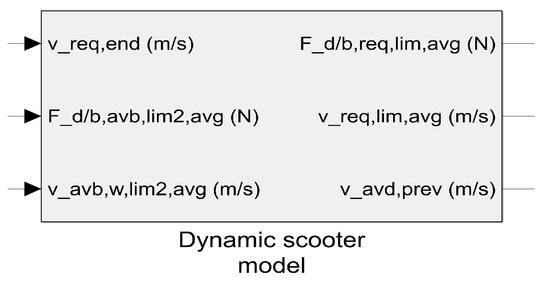
Figure 5.
Dynamic scooter model block.
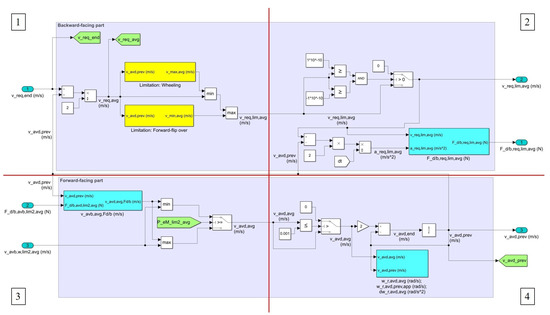
Figure 6.
The detailed structure of the dynamic scooter model block.
Throughout the model, the input and output are shown with oval blue icons. Parameters that are calculated within the model and used elsewhere are shown with green pentagon arrows. The calculation of limit values via system limitation is conducted in the blocks shown in yellow. Calculations of the respective output parameters are summarized in the light blue blocks.
The dynamic scooter model block can be divided into a backward-facing part and a forward-facing part. These two approaches are each highlighted by a violet background color.
For better readability, the dynamic scooter block is divided into four parts, which are shown separately below. Parts 1 and 2 contain the backward-facing part and parts 3 and 4 contain the forward-facing part.
Firstly, the dynamic scooter model block obtains the desired speed vreq,end from the driving cycle block and represents the input size of the backward-facing part (shown in Figure 7). This value represents the required speed at the end of the time step. Taking the velocity value reached in the previous time step vavd,prev into account, the required average speed vreq,avg is calculated as follows:
where vreq,avg is the required average speed (m/s), vreq,end is the required speed at the end of the time step (m/s), and vavd,prev is the achieved speed at the beginning of the time step (m/s).
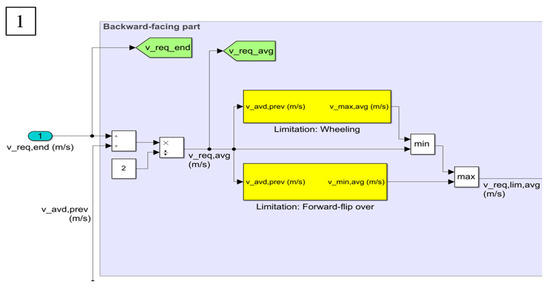
Figure 7.
The detailed structure of part 1 in the dynamic scooter model block.
Then, the limit speeds at which the undesirable driving conditions wheeling and forward-flip over occur are calculated. These speeds are the first limitations of the scooter model. The calculation is performed in the yellow blocks in Figure 7. In order to prevent wheeling and thus lifting of the front wheel, the maximum acceleration of the scooter must be limited. This also limits the average speed and the final speed of the time step. For the acceleration , the following expression is used:
where amax,avg is the maximum average acceleration (m/s2), vmax.avg is the maximum average speed (m/s), vavd,prev is the previous reached speed (m/s), and dt is the time increment (s). The contained acceleration corresponds to the following term:
where amin,avg is the minimum average acceleration (m/s2) which is present at maximum braking, vmin,avg is the minimum average speed (m/s), vavd, prev is the previously reached speed (m/s), and dt is the time increment (s).
The following condition must therefore apply to ensure safe driving conditions:
The consideration of this condition leads to the limited required average velocity value vreq,lim,avg. This is the input parameter of part 2.
In part 2, which is mapped in Figure 8, the initial acceleration areq,lim,avg is calculated by the following term:
where areq,lim,avg and vreq,lim,avg are the average limited required acceleration (m/s2) and speed (m/s), vavd,prev is the previous reached speed (m/s), and dt is the time increment (s). Taking into account the average speed vreq,lim,avg and the corresponding average acceleration areq,lim,avg, the required limited necessary average driving or braking force Fd/b.req,lim,avg is calculated. The calculated limited required average speed vreq,lim,avg and the associated required driving or braking force Fd/b.req,lim,avg are routed to the wheels block.
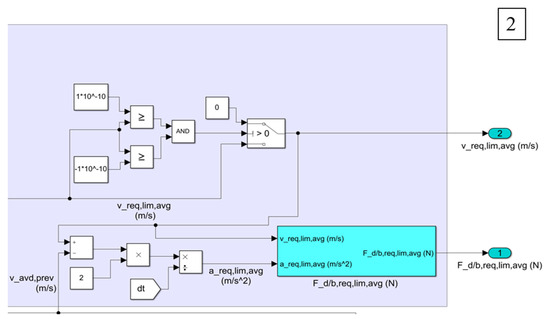
Figure 8.
The detailed structure of part 2 in the dynamic scooter model block.
The forward-facing part of the dynamic scooter model block has the calculated average driving or braking force Fd/b,avb,lim2,avg and achieved average speed vavd,w,lim2,avg (shown in Figure 9). These parameters are the initial parameters of the wheel block. Typically, there is a relationship between the speed of the scooter and the driving force. However, this relationship no longer applies to the input values. The reason for this is the calculations of the electric motor block. Therefore, at the beginning of the forward-facing part, the acceleration containing corresponds to the following term:
where aavb,avg,Fd/b is the available average acceleration based on Fd/b,avb,lim2,avg (m/s2), vavb,avg,Fd/b is the available average velocity based on Fd/b,avb,lim2,avg (m/s), vavd, prev is the achieved previous velocity (m/s), and dt is the time increment (s). Depending on the required power of the electric motor PeM,lim2,avg, the achieved average speed vavd,avg of the scooter has different values. As shown in part 4 (Figure 10), the achieved velocity value at the end of the time step vavd,end is calculated as:
where vavd,end is the achieved velocity at the end of the time step (m/s), vavd,avg is the achieved average velocity of the scooter (m/s), and vavd,prev is the previously achieved velocity (m/s). Using a Unit Delay block from the Simulink library, the previously achieved velocity vavd,prev is calculated. With the speed values obtained, the average angular velocity and acceleration of the rear tire are also calculated. ωavd,mid,r and dωavd,mid,r are taken into account in the determination of the tire slip (light blue block in Figure 10). These values are used in the electric motor block.
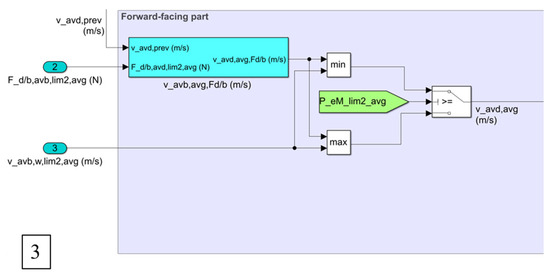
Figure 9.
The detailed structure of part 3 in the dynamic scooter model block.

Figure 10.
The detailed structure of part 4 in the dynamic scooter model block.
Since the emphasis in this study is on the passive fuel cell–battery hybrid system, the detailed structures of other blocks are listed as follows, without further explanation. Figure 11 shows the detailed structure of the wheel block. Figure 12 shows the detailed structure of the electric machine block. Figure 13 shows the detailed structure of the auxiliary consumer block. Figure 14 shows the overview of the power bus block. Figure 15 shows the detailed structure of the hydrogen tank block.
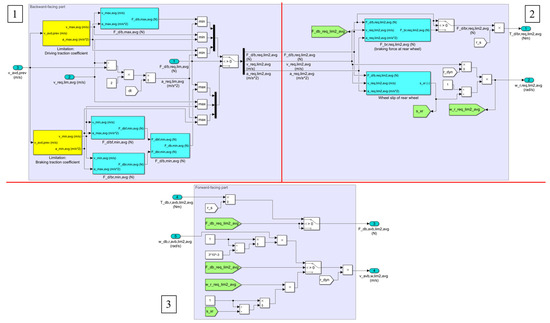
Figure 11.
The detailed structure of the wheel block.
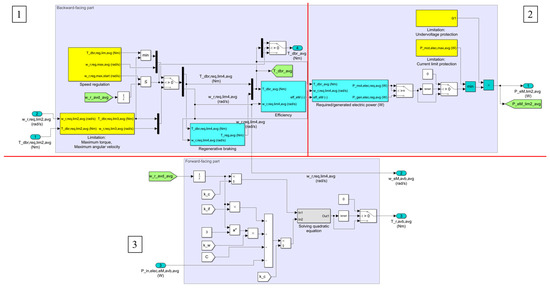
Figure 12.
The detailed structure of the electric machine block.
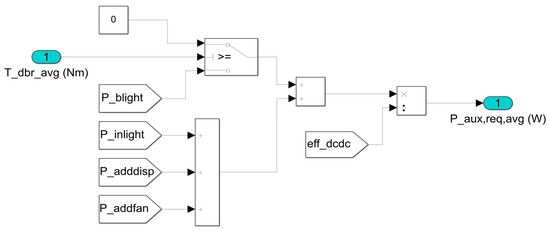
Figure 13.
The detailed structure of auxiliary consumers block.
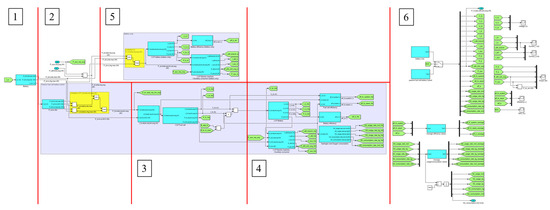
Figure 14.
The overview of the power bus block.

Figure 15.
The detailed structure of the hydrogen tank block.
The structure of the power bus block (Figure 14) is divided into six parts for further explanation. Basically, the model can be divided into four main sections. The first section consists of the battery model, which is shown in part 1. Parts 2–4 contain the calculations for the passive fuel cell–battery hybrid and represent the second main section. The next main section consists of part 5, where a power bus is simulated, which is driven by the battery only. The last main section is part 6, where the characteristics of the scooter system are collected.
4. Experimental Validation
4.1. ECE-R47-Based Driving Cycle
The ECE-R47-based driving cycle (Economic Commission for Europe Regulation 47) is a legislated test cycle consisting of a repeating (ECE R) single cycle, which is based on modal operation sections and has a total duration of 112 s (shown in Table 1) [30].

Table 1.
The modal sequence of the ECE R47 single cycle [30].
This driving profile is intended to simulate the driving situation in a congested urban area and is part of the test procedure for the certification of the EURO 1 to EURO 4 emissions standards for two-wheeled mopeds. In these emissions standards, the single cycle is repeated eight times in succession and, depending on the standard, the emission of carbon monoxide (CO), total hydrocarbons (THC), and nitrogen oxides (NOx) is determined during the last four single cycles (EURO 1, EURO 2) or over the entire driving cycle (EURO 3, EURO 4) [31,32,33]. Figure 16 shows the speed profile of the driving cycle for a moped with a maximum speed of 50 km/h.
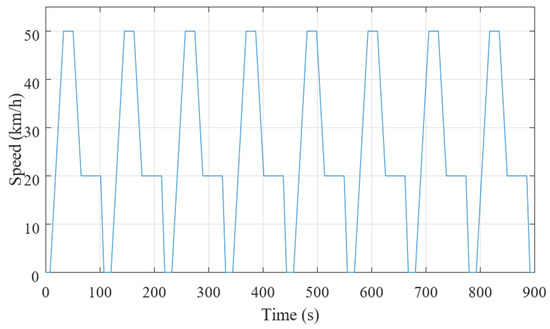
Figure 16.
ECE-R47 driving cycle.
ECE R47-based driving cycles are also used for certification procedures in Asian countries such as China, South Korea, and Thailand. In China, this driving cycle is part of Stage IV of the current emission standards for mopeds (engine capacity ≤ 50 cm3, maximum design speed ≤ 50 km/h) and is furthermore used to determine the energy consumption and range of electric motorcycles and mopeds [34,35].
4.2. Test Facilities and Setup
A modified electric scooter was available for the overall vehicle tests, in which a passive fuel cell–battery electric hybrid drive train was installed. A picture of the scooter with the packaging of selected powertrain components is shown in Figure 17.
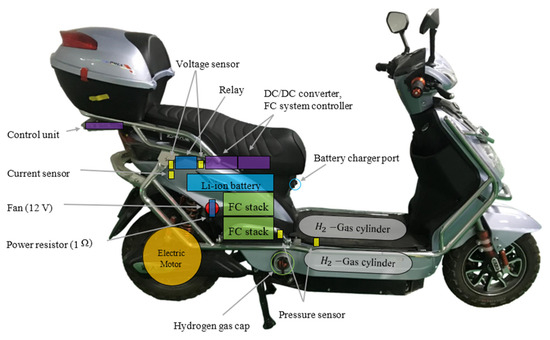
Figure 17.
Passive fuel cell–battery hybrid electric scooter with the assembly of selected components.
The hydrogen is stored in two gas cylinders with a storage volume of 3 L each at a pressure of a maximum of 350 bar. The gas cylinders are located below the footplate and are connected to each other by a gas line. The opening and closing of the gas line are facilitated by a stop valve. Two pressure regulators reduce the pressure first to approximately 20 bar and then to approximately 0.5 bar. Two pressure sensors measure the pressure in the gas cylinders or the pressure level after the second pressure regulator. Figure 18 shows the hydrogen tank system of the scooter in the top view.
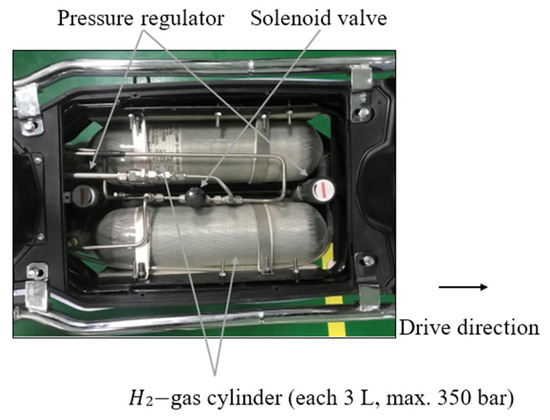
Figure 18.
Hydrogen tank system in the scooter.
The fuel cell systems are connected in series, and the resulting voltage is the sum of the individual voltages of the fuel cell systems. The resulting voltage is determined by a voltage sensor connected in parallel.
In addition to the fuel cell systems, a Li-ion battery (48 V, 12 Ah; manufacturer: Divine shield, Dongguan City, China, model: SEDUN-DL) is installed as energy storage. This battery contains a simple battery management system, which ensures that the appropriate operating conditions are maintained and, if necessary, disconnects the battery from the electric main circuit. The voltage of the battery is measured with a voltage sensor. In addition, two relays enable the connection and disconnection of the energy carriers from the electric main circuit. To reduce the current flow from the fuel cells to the battery in case of battery charging, a 1 Ω power resistor is connected after the fuel cell. Meanwhile, the power resistor is cooled by a fan (12 V, 0.18 A).
The test setup is shown in Figure 19. The scooter is mounted with the front wheel in a tire clamp and the rear wheel is placed on a roller which adjusts the driving resistance of the scooter during the test cycles. The roller unit also determines the speed and acceleration of the drive wheel. The front wheel assembly can be lifted to increase the gradient of the road. Cooling during the test is provided by a cooling fan located in front of the scooter.
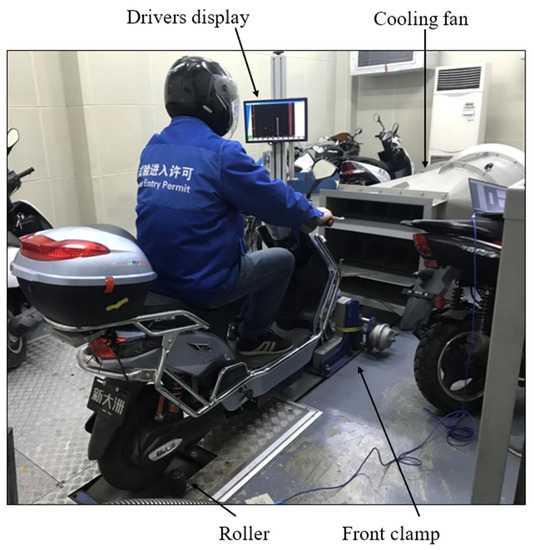
Figure 19.
Test setup.
4.3. Comparison between Test and Simulation
A comparison of the test data with the simulation data of the battery and fuel cell power is shown in Figure 20 and Figure 21, respectively. There is a basic agreement of the curve progressions between the test and the simulation for both components.

Figure 20.
Comparison of battery power based on test and simulation data in test run ECE-R47.
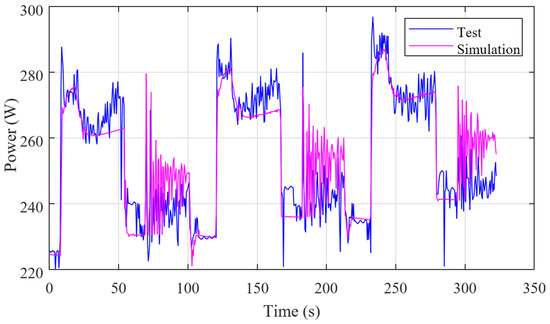
Figure 21.
Comparison of fuel cell power based on test and simulation data in ECE-R47 test run.
With the data of the battery, it can be seen that with high-performance requirements, the values of the simulation curve remain below those of the test curve. This can be observed for three time periods during the test run: (1) t = 10 s to t = 20 s; (2) t = 122 s to t = 132 s; (3) t = 234 s to t = 244 s. During the first period, there is an average difference of about 148.62 W.
In the time ranges t = 102 s to t = 107 s and t = 214 s to t = 219 s, a negative deflection in the simulation data in contrast to the test data can be seen. In this range, regenerative braking takes place in the simulation model, which leads to power feedback to the battery. In the test, however, no additional power flow caused by regenerative braking can be detected due to the lack of current data.
In the test data of the fuel cell as shown in Figure 21, a clear fluctuation can be seen at high power values. The simulation values, however, show only slight fluctuations in these areas, which are small and acceptable. The simulation values are, for the most part, within the fluctuation range of the test data. As already seen with the battery performance, there are strong fluctuations in the ranges of constant speed of 20 km/h, both in the test and in the simulation. The simulation data are also on average above the test data here. Regenerative braking can also be seen in the simulation data in the ranges t = 102 s to t = 107 s and t = 214 s to t = 219 s.
The following are the current values of the electric motor branch (shown in Figure 22), the battery (shown in Figure 23), and the fuel cell (shown in Figure 24). All in all, the three figures show a basic agreement between the test and the simulation. The curve progression of the current values for the electric motor and the battery are similar to those of the battery power curves described above. At high current flows, the simulation values are below those of the test, and at a constant speed, the simulation values have a higher value. In addition, a negative peak is observed in both current curves of the simulation at the periods t = 102 s to 107 s and t = 214 s to t = 219 s, which is caused by regenerative braking.
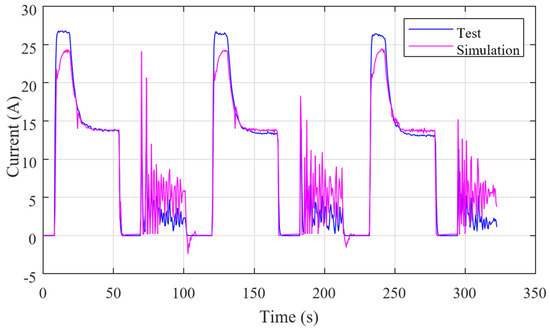
Figure 22.
Comparison of electric motor branch current based on test and simulation data in ECE-R47 test run.
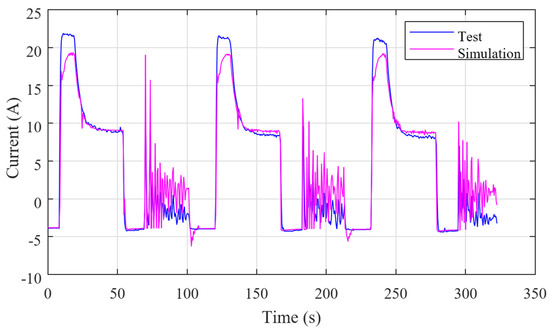
Figure 23.
Comparison of battery current based on test and simulation data in ECE-R47 test run.
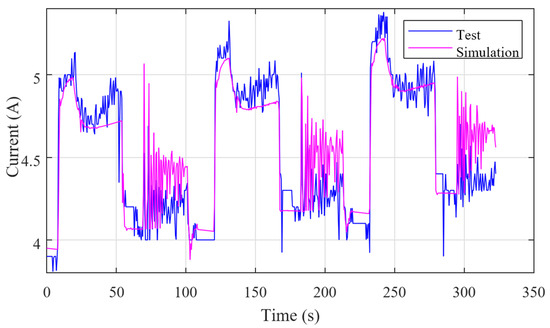
Figure 24.
Comparison of fuel cell current based on test and simulation data in ECE-R47 test run.
The current values of the fuel cell in Figure 24 are also similar to the power curves in Figure 21. The largest deviations between the test and the simulation take place in the areas of a constant speed of 20 km/h.
Figure 25 shows the voltage curves of the battery, and Figure 26 shows the data of the fuel cell. As before, the curves from the simulations correspond to those from the test. For both the battery and the fuel cell, the value ranges from the simulation are smaller than in the test. For the battery, the greatest differences occur in the ranges of lower voltage values. At higher voltages, such as a constant driving speed of 20 km/h, the differences are small. With the fuel cell, this is reversed. At low voltage, the smallest differences are found. However, higher deviations are found at medium and high voltage values. As with the current values, fluctuations can be seen in the measured voltage values of the fuel cell. In addition to these regular fluctuations, a voltage increase can be observed both in the test and in the simulation during regenerative braking. This is also the case with the battery, but in the test, as well as in the simulation, the voltage increases during braking.
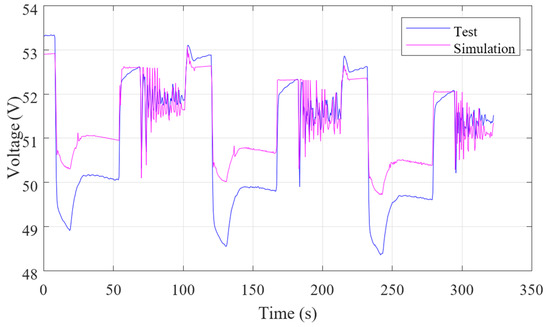
Figure 25.
Comparison of battery voltage based on test and simulation data in ECE-R47 test run.
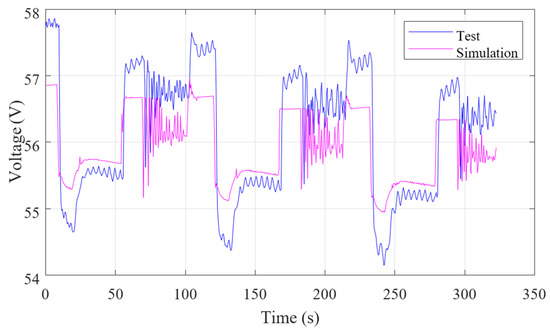
Figure 26.
Comparison of fuel cell voltage based on test and simulation data in ECE-R47 test run.
Finally, the hydrogen tank pressure curve is compared between the test and the simulation, as shown in Figure 27. Due to the almost constant drop in pressure during the test run, there is a very high level of agreement between the two curves.
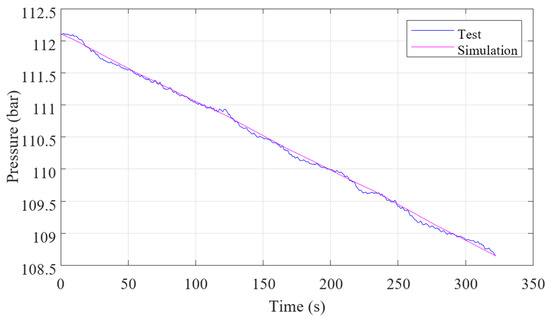
Figure 27.
Comparison of hydrogen tank pressure based on test and simulation data in ECE-R47 test run.
In summary, and taking into account all the results, the accuracies achieved are considered sufficient. The parameters of the fuel cell are in high agreement. The maximum relative deviation is 2.82% for the current value. The average relative deviations of the battery are significantly larger. However, the average absolute deviations are Ib = 2.48 A and Pb = 117.34 W, in areas where the condition of the passive fuel cell–battery powertrain can be determined.
5. Discussion
In this study, a simulation model was established to check whether the conditions of the passive fuel cell–battery hybrid electric scooter can be realistically represented. The steady-state simulation model created in MATLAB/Simulink worked with the backward–forward approach. The fuel cell was modeled by a modified steady-state model. The battery model was calculated by using a simplified model.
The scooter was powered by two air–hydrogen PEMFC systems with a nominal power of 250 W each and a Li-ion battery (48 V, 12 Ah). The hydrogen inlet pressure of the fuel cell stacks was approximately 0.5 bar. The fuel cell systems were air-cooled. The hydrogen tank contained two gas cylinders with a storage volume of 3 L each and a maximum storage pressure of 350 bar.
Considering the power split of the fuel cell and battery, the fuel cell showed small variations in the operating points throughout the test. No relevant transient behavior of the fuel cell was found. The battery was able to deliver the required power during dynamic load changes. It is likely that regenerative braking took place.
A test run (ECE-R47) was carried out to validate the simulation model. The graphical analysis showed similar progressions of test and simulation data. There was a high agreement between the test data of the fuel cell and the battery voltage. The maximum relative deviation of the fuel cell is 2.82% for the current value. However, the average absolute deviations are Ib = 2.48 A and Pb = 117.34 W, in areas where the condition of the passive fuel cell–battery powertrain can be determined with certain accuracy.
In summary, the results from the test and the simulation are in agreement. The direct coupling of the fuel cell and the battery was simulated in the created simulation model. This confirms the working hypothesis that the condition of a passive fuel cell–battery hybrid electric scooter is realistically represented by this simulation model. This work can provide an efficient assessment and a design direction for passive fuel cell–battery hybrid electric scooters.
Author Contributions
Conceptualization, Z.Z. and T.Z.; methodology, Z.Z. and A.R.; software, A.R. and Z.Z.; validation, X.Z. and J.Z. (Jinming Zhang); resources, Z.Z. and J.Z. (Jiaming Zhou); writing—original draft preparation, Z.Z. and A.R.; writing—review and editing, Z.Z. and G.H.; funding acquisition, Z.Z. and J.Z. (Jiaming Zhou). All authors have read and agreed to the published version of the manuscript.
Funding
This research was funded by the Natural Science Foundation of Shanghai, grant number 22ZR1466800, and the Weifang University of Science and Technology High-level Talent Research Start-up Fund Project, grant number KJRC2023001.
Institutional Review Board Statement
Not applicable.
Informed Consent Statement
Not applicable.
Data Availability Statement
Not applicable.
Conflicts of Interest
The authors declare no conflict of interest.
References
- Ravi, N.; Ekram, S.; Mahajan, D. Design and development of a in-wheel brushless D.C. motor drive for an electric scooter. In Proceedings of the 2006 International Conference on Power Electronic, Drives and Energy Systems, New Delhi, India, 12–15 December 2006; pp. 1–4. [Google Scholar] [CrossRef]
- Xu, X.; Zhao, J.; Zhao, J.; Shi, K.; Dong, P.; Wang, S.; Liu, Y.; Guo, W.; Liu, X. Comparative study on fuel saving potential of series-parallel hybrid transmission and series hybrid transmission. Energy Convers. Manag. 2022, 252, 114970. [Google Scholar] [CrossRef]
- Hu, D.; Cheng, S.; Zhou, J.; Hu, L. Energy Management Optimization Method of Plug-In Hybrid-Electric Bus Based on Incremental Learning. IEEE J. Emerg. Sel. Top. Power Electron. 2023, 11, 7–18. [Google Scholar] [CrossRef]
- Jia, C.; Zhou, J.; He, H.; Li, J.; Wei, Z.; Li, K.; Shi, M. A novel energy management strategy for hybrid electric bus with fuel cell health and battery thermal-and health-constrained awareness. Energy 2023, 271, 127105. [Google Scholar] [CrossRef]
- Lu, D.; Hu, D.; Yi, F.; Li, J.; Yang, Q. Optimal selection range of FCV power battery capacity considering the synergistic decay of dual power source lifespan. Int. J. Hydrogen Energy 2023, 48, 13578–13590. [Google Scholar] [CrossRef]
- Jiang, Z.; Gao, L.; Blackwelder, M.J.; Dougal, R.A. Design and experimental tests of control strategies for active hybrid fuel cell/battery power sources. J. Power Sources 2004, 130, 163–171. [Google Scholar] [CrossRef]
- Dong, P.; Zhao, J.; Liu, X.; Wu, J.; Xu, X.; Liu, Y.; Wang, S.; Guo, W. Practical application of energy management strategy for hybrid electric vehicles based on intelligent and connected technologies: Development stages, challenges, and future trends. Renew. Sustain. Energy Rev. 2022, 170, 112947. [Google Scholar] [CrossRef]
- Blackwelder, M.J.; Dougal, R.A. Power coordination in a fuel cell–battery hybrid power source using commercial power controller circuits. J. Power Sources 2004, 134, 139–147. [Google Scholar] [CrossRef]
- Zhang, Y.; Zhang, C.; Huang, Z.; Xu, L.; Liu, Z.; Liu, M. Real-time energy management strategy for fuel cell range extender vehicles based on nonlinear control. IEEE Trans. Transp. Electrif. 2019, 5, 1294–1305. [Google Scholar] [CrossRef]
- Gao, L.; Jiang, Z.; Dougal, R.A. An actively controlled fuel cell/battery hybrid to meet pulsed power demands. J. Power Sources 2004, 130, 202–207. [Google Scholar] [CrossRef]
- Zeng, T.; Zhang, C.; Zhang, Y.; Deng, C.; Hao, D.; Zhu, Z.; Ran, H.; Cao, D. Optimization-oriented adaptive equivalent consumption minimization strategy based on short-term demand power prediction for fuel cell hybrid vehicle. Energy 2021, 227, 120305. [Google Scholar] [CrossRef]
- González, E.L.; Cuesta, J.S.; Fernandez, F.J.V.; Llerena, F.I.; Carlini, M.A.R.; Bordons, C.; Hernandez, E.; Elfes, A. Experimental evaluation of a passive fuel cell/battery hybrid power system for an unmanned ground vehicle. Int. J. Hydrogen Energy 2019, 44, 12772–12782. [Google Scholar] [CrossRef]
- Jia, C.; Li, K.; He, H.; Zhou, J.; Li, J.; Wei, Z. Health-aware energy management strategy for fuel cell hybrid bus considering air-conditioning control based on TD3 algorithm. Energy 2023, 283, 128462. [Google Scholar] [CrossRef]
- Al-Ali, A.; Waheed, W.; Abu-Nada, E.; Alazzam, A. A review of active and passive hybrid systems based on Dielectrophoresis for the manipulation of microparticles. J. Chromatogr. A 2022, 1676, 463268. [Google Scholar] [CrossRef] [PubMed]
- Zhang, Y.; Tennakoon, T.; Chan, Y.H.; Chan, K.C.; Fu, S.C.; Tso, C.Y.; Yu, K.M.; Huang, B.L.; Yao, S.H.; Qiu, H.H.; et al. Energy consumption modelling of a passive hybrid system for office buildings in different climates. Energy 2022, 239, 121914. [Google Scholar] [CrossRef]
- Offer, G.J. Fuel Cell Hybrid Electric Vehicle Powertrain Modelling and Testing. Ph.D. Thesis, Imperial College London, London, UK, 2014. [Google Scholar]
- Andreasen, S.J.; Ashworth, L.; Menjón Remón, I.N.; Kær, S.K. Directly connected series coupled HTPEM fuel cell stacks to a Li-ion battery DC bus for a fuel cell electrical vehicle. Int. J. Hydrogen Energy 2008, 33, 7137–7145. [Google Scholar] [CrossRef]
- Renken, F.; Piwczyk, D.; Shen, W.; Pop-Calimanu, I.M.; Steinberger-Wilckens, R. A Novel Concept to Control the Powertrain in Battery Fuel Cell Hybrid Vehicles. In Proceedings of the 2018 20th European Conference on Power Electronics and Applications (EPE’18 ECCE Europe), Riga, Latvia, 17–21 September 2018; pp. 1–9. Available online: https://ieeexplore.ieee.org/xpl/conhome/8493084/proceeding (accessed on 20 September 2020).
- Nishizawa, A.; Kallo, J.; Garrot, O.; Weiss-Ungethüm, J. Fuel cell and Li-ion battery direct hybridization system for aircraft applications. J. Power Sources 2013, 222, 294–300. [Google Scholar] [CrossRef]
- Bernard, J.; Hofer, M.; Hannesen, U.; Toth, A.; Tsukada, A.; Büchi, F.N.; Dietrich, P. Fuel cell/battery passive hybrid power source for electric powertrains. J. Power Sources 2011, 196, 5867–5872. [Google Scholar] [CrossRef]
- Wu, B.; Parkes, M.A.; Yufit, V.; De Benedetti, L.; Veismann, S.; Wirsching, C.; Vesper, F.; Martinez-Botas, R.F.; Marquis, A.J.; Offer, G.J.; et al. Design and testing of a 9.5 kWe proton exchange membrane fuel cell–supercapacitor passive hybrid system. Int. J. Hydrogen Energy 2014, 39, 7885–7896. [Google Scholar] [CrossRef]
- Pisu, P.; Cantemir, C.-G.; Dembski, N.; Rizzoni, G.; Serrao, L.; Josephson, J.R.; Russell, J. Evaluation of powertrain solutions for future tactical truck vehicle systems. In Modeling and Simulation for Military Applications; SPIE: Bellingham, WA, USA, 2006; Volume 6228, pp. 105–116. [Google Scholar] [CrossRef]
- Sun, L.; You, F. Machine learning and data-driven techniques for the control of smart power generation systems: An uncertainty handling perspective. Engineering 2021, 7, 1239–1247. [Google Scholar] [CrossRef]
- Zou, Y.; Li, J.; Hu, X.; Chamaillard, Y. Modeling and Control of Hybrid Propulsion System for Ground Vehicles; Springer: Berlin/Heidelberg, Germany, 2018. [Google Scholar] [CrossRef]
- Onori, S.; Serrao, L.; Rizzoni, G. Hybrid Electric Vehicles: Energy Management Strategies; Springer London Ltd.: London, UK, 2016. [Google Scholar] [CrossRef]
- Dixon, G.; Stobart, R.; Steffen, T. Unified Backwards Facing and Forwards Facing Simulation of a Hybrid Electric Vehicle Using MATLAB Simscape; SAE Technical Paper 2015-01-1215; SAE International: Warrendale, PA, USA, 2015. [Google Scholar] [CrossRef]
- Gao, D.W.; Mi, C.; Emadi, A. Modeling and simulation of electric and hybrid vehicles. Proc. IEEE 2007, 95, 729–745. [Google Scholar] [CrossRef]
- Hellberg, T.; Meywerk, M. Usage-based optimisation of characteristic maps for conceptual powertrain design. Automot. Engine Technol. 2017, 2, 49–61. [Google Scholar] [CrossRef]
- Zhou, J.; Feng, C.; Su, Q.; Jiang, S.; Fan, Z.; Ruan, J.; Sun, S.; Hu, L. The Multi-Objective Optimization of Powertrain Design and Energy Management Strategy for Fuel Cell–Battery Electric Vehicle. Sustainability 2022, 14, 6320. [Google Scholar] [CrossRef]
- European Union. OJ L 53—Commission Delegated Regulation (EU) No 134/2014 of 16 December 2013 Supplementing Regulation (EU) No 168/2013 of the European Parliament and of the Council with Regard to Environmental and Propulsion Unit Performance Requirements and Amending Annex V Thereof, 21 February 2014. Available online: http://data.europa.eu/eli/reg_del/2014/134/2018-03-20 (accessed on 2 May 2020).
- European Union. Regulation (EU) No 168/2013 of the European Parliament and of the Council of 15 January 2013 on the Approval and Market Surveillance of Two- or Three-Wheel Vehicles and Quadricycles: 02013R0168-20190220, 20 February 2019. Available online: http://data.europa.eu/eli/reg/2013/168/2019-02-20 (accessed on 2 May 2020).
- United Nations Economic Commission for Europe. UN Regulation No. 47—Emission of Gaseous Pollutants of Mopeds. 1981. Available online: https://www.unece.org/fileadmin/DAM/trans/main/wp29/wp29regs/r047e.pdf (accessed on 2 May 2020).
- Giechaskiel, B.; Zardini, A.; Martini, G. Particle emission measurements from L-category vehicles. SAE Int. J. Engines 2015, 8, 2322–2337. [Google Scholar] [CrossRef]
- GB/T 24157-2017; Test Methods of Range and Indication for the State of Charge of Electric Motorcycle and Electric Mopeds. The Standardization Administration of the People’s Republic of China: Beijing, China. 2017. Available online: http://c.gb688.cn/bzgk/gb/showGb?type=online&hcno=719EBA32808F06FCCDE397C721C57A65 (accessed on 2 May 2020).
- Delphi Technologies PLC. Worldwide Emissions Standards—Passenger Cars and Light Duty Vehicles 2019–2020. Available online: https://www.delphi.com/innovations (accessed on 2 May 2020).
Disclaimer/Publisher’s Note: The statements, opinions and data contained in all publications are solely those of the individual author(s) and contributor(s) and not of MDPI and/or the editor(s). MDPI and/or the editor(s) disclaim responsibility for any injury to people or property resulting from any ideas, methods, instructions or products referred to in the content. |
© 2023 by the authors. Licensee MDPI, Basel, Switzerland. This article is an open access article distributed under the terms and conditions of the Creative Commons Attribution (CC BY) license (https://creativecommons.org/licenses/by/4.0/).